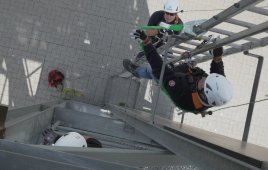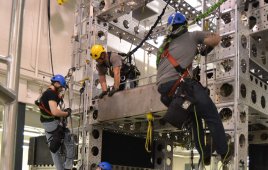Automatic fire-suppression equipment has been developed to protect critical components in wind turbines regardless of location. The systems work without need of external power so they can activate around-the-clock and without manual activation or monitoring.
Some claim to require no maintenance. One design starts with a cylinder filled with an extinguishing agent. A long length of leak-resistant and proprietary polymer tubing loops around likely heat sources to serve as a pneumatic heat-and-flame detector immune to shock and vibration. The tube provides a temperature-sensitive detector and suppression delivery device. When exposed to a fire’s heat and radiant energy, the tube bursts and directs the extinguishing agent to the fire’s source before it can take hold and do extensive damage to the turbine.
Instead of trying to protect the entire turbine, these area-specific systems protect critical areas most prone to fire, such as electrical enclosures, near generators, and adjacent cabinets housing controls or electrical transmission equipment. Such systems can also protect brakes, generator enclosures, SCADA [Supervisory Control and Data Acquisition] systems, and hydraulic systems with potential to rupture near points of potential ignition. The design is said to overcome major drawbacks of traditional flooding suppression systems.
Another family of fire suppression devices is based on aerosol technology developed in the space program. The patented potassium-based aerosol works by chemically interfering with free radicals in flame. The company says the aerosol stream contains 1 to 2 micron particles of potassium compounds that provide a large surface-area interaction with the fire. Free potassium radicals in the fire zone bind with the free radicals of the fire (O, OH, H) to rapidly slow and extinguish the fire. Tests on class B fires are claimed to have shown it five times more effective than halon and over 10 times more effective than halon alternatives. The manufacturer says it is ecologically safe.
These small self-contained generators mount at ceiling height. The units have a patented thermal detector built to the generator—eliminating need for ancillary detection and releasing devices. Units are available in several temperature settings to insure applicability to the equipment being protected.
Stand alone (thermal) units have their own detection mechanism, eliminating need for separate detection and releasing controls. Suitable for many applications in smaller enclosures, they are available in sizes from 30 grams (covering up to 0.5 m3) up to 500 grams (covering up to 8 m3). Units are constructed of stainless steel components, listed for both area and volumetric coverage, and require no piping, nozzles, or other distribution equipment. This generator acts as its own storage, production, and delivery device. The devices are suitable for use in normally unoccupied enclosed volumes, they have the advantages of extended hold times, and are less susceptible to leakage.
The unit’s aerosol generator provides a controlled combustion to produce an ultra fine extinguishing agent, and according to the manufacturer, more effective than alternatives. The aerosol passes through oxidation and cooling filters where its temperature drops before it discharges through ports at low pressure. Generator placement in a nacelle or tower provides a proper flow and distribution.
Reducing combustible or smoke-generating material in the nacelle further reduces the chance of fire. To that end, a recent thermoplastic polyurethane (TPU), for wire insulation, generates less smoke than conventional insulations in the case of arcing or fire. The material is intended for wire and cable jacketing in nonhalogen, flame-retardant applications. Industry is placing greater emphasis on the development of new compounds that produce less smoke and higher Limited Oxygen Index (LOI) to reduce the spreading of flames. This TPU is said to meet industry’s demand for wire and cable jacketing used in applications that need low-smoke fire resistant materials. The material provides an LOI of 33 and achieves a UL vertical burn rating of V0. Low-smoke TPUs also feature greater resistance to abrasion, wear, tear, and puncture than materials such as rubber or PVC.
Filed Under: Safety






Thank you ever so for you blog post.Really thank you! Really Cool.
Thanks for reading 🙂